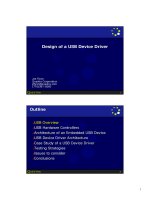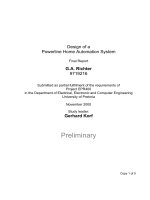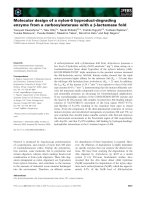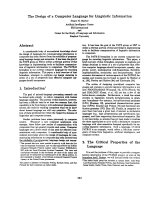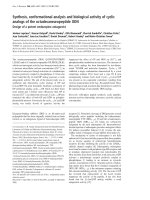Design of A Circularly Polarized E-shaped Patch Antenna with Enhanced Bandwidth for 2.4 GHz WLAN Applications
Bạn đang xem bản rút gọn của tài liệu. Xem và tải ngay bản đầy đủ của tài liệu tại đây (280.69 KB, 7 trang )
<span class='text_page_counter'>(1)</span><div class='page_container' data-page=1>
Design of A Circularly Polarized E-shaped Patch Antenna
with Enhanced Bandwidth for 2.4 GHz WLAN Applications
Hong Van Tam
1, Luong Vinh Quoc Danh
*,2<i>1</i>
<i>Vinaphone Company, Vietnam </i>
<i>2</i>
<i>Department of Electronics and Telecommunication Engineering, </i>
<i>College of Engineering Technology, Can Tho University, Vietnam </i>
<b>Abstract </b>
This paper presents the design of a wideband circularly polarized E-shaped patch antenna for 2.4-GHz wireless
local area networks (WLAN) applications. The proposed antenna is a modified form of the conventional
circularly polarized E-shaped patch antenna. By incorporating additional slots into the antenna patch, the
impedance bandwidth and return loss of the circularly polarized antenna are improved by about 6.5% and 12 dB,
respectively. Measurements of the fabricated antennas show good agreement with simulated results.
© 2015 Published by VNU Journal of Science.
Manuscript communication: received 30 April 2014, revised 04 May 2015, accepted 25 June 2015
Corresponding author: Luong Vinh Quoc Danh,
<i>Keywords:</i> Axial Ratio, Circular Polarization, E-shaped Patch, WLAN.
<b>1. Introduction </b>
Circularly-polarized antennas have been
employed in many modern wireless
communication systems such as navigation,
satellite communication systems, radio
frequency identification (RFID), WLAN and
WiMAX. One of the attractive advantages of
the circularly polarized antennas is that they can
reduce transmission loss caused by the
misalignment between antennas of transmitter
and receiver. In addition, circular polarization
provides better ability to combat multi-path
fading problem and thus enhances overall
system performance.
In [1], the authors have presented a
circularly polarized E-shaped patch antenna
with unequal slots that offers wideband axial
ratio bandwidth compared to the U-slot patch
antennas. The design introduced in [1] has
provided a simple approach to achieve
circularly polarized radiating fields from a
single-feed microstrip antenna without the
necessity of it being square or comer-trimmed.
In [2], the size and position of the slots of the
E-shaped patch antenna have been tuned to
improve the impedance bandwidth and return
loss. The results from [2] have shown that the –
10 dB impedance bandwidth of about 21.6%
was obtained (2.28-2.81 GHz), with a lowest
<i>value of S11</i> of –17.5 dB in the 2.4-2.5 GHz
band. The axial-ratio of this antenna was kept
below 3 dB in the 2.4 GHz WLAN band.
</div>
<span class='text_page_counter'>(2)</span><div class='page_container' data-page=2>
wider impedance bandwidth and better return
loss compared to the conventional one. By
properly incorporating additional slots to the
E-shaped patch, the impedance bandwidth and
<i>return loss S11</i> of the proposed antenna are
improved by about 6.5% and 12 dB,
respectively. The axial ratio remains below 3
dB in the 2.4 GHz WLAN band. Measurements
of the fabricated antennas show good agreement
with simulated results.
<b>2. Features of the E-shaped Patch Antennas </b>
Fig. 1 presents the geometry of the
conventional E-shaped patch antenna [1] and
the modified one. As shown in Fig. 1b,
compared to the conventional E-shaped patch
antenna, the proposed antenna has 3 additional
slots incorporated into the patch. Two slots
<i>having length of d1 and width of d2</i> are made on
the top and bottom arms of the E-shaped patch
<i>and another slot having length of d3</i> and width
<i>of d4</i> is added to the center of the patch. The
dimension and position of the slots are key
parameters in controlling the antenna
bandwidth. They should be appropriately
chosen to obtain the achievable bandwidth.
The principle of the bandwidth
improvement can be explained using equivalent
circuits of the patch. Fig. 2 illustrates the
fundamental idea of the wideband mechanism
of the E-shaped patch antenna. The upper and
lower parts of the patch can be modeled as the
<i>L1C1 and L2C2</i> resonant circuits, respectively
[3]. When the additional slots are incorporated
into the lower and upper arms of the E-shaped
<i>patch, the values of L and C in the resonant </i>
<i>circuits are changed. By tuning the length d1</i>,
<i>width d2 and position P1</i> of the slots, the
<i>resonant feature of the L1C1 and L2C2</i> resonant
circuits can be altered to extend the impedance
bandwidth of the antenna.
<b>3. E-shaped Patch Antenna Design for 2.4 </b>
<b>GHz WLAN Applications </b>
The initial parameters of the rectangular
microstrip patch antenna defined in [4] are used
in the first step of the design process.
<i>The width W of the rectangular patch is: </i>
1
2 +
=
<i>r</i>
<i>r</i>
<i>f</i>
<i>c</i>
<i>W</i>
ε
(1)
<i>where fr </i>is the resonant frequency of the
antenna.
<i>The actual length L of the patch: </i>
<i>L</i>
<i>f</i>
<i>c</i>
<i>L</i>
<i>reff</i>
<i>r</i>
∆
−
= <sub>2</sub>
ε
(2)
<i>Extended length of the patch ∆L (according </i>
to the Hammerstad formula):
+
−
+
+
×
=
∆
8
.
0
)
258
.
0
(
264
.
0
)
3
.
0
(
412
.
0
<i>h</i>
<i>W</i>
<i>h</i>
<i>W</i>
<i>h</i>
<i>L</i>
<i>reff</i>
<i>reff</i>
ε
ε
(3)
Effective permittivity of the patch ε<i>reff </i>:
2
1
12
1
2
1
2
1 −
+
−
+
+
=
<i>W</i>
<i>h</i>
<i>r</i>
<i>r</i>
<i>reff</i>
ε
ε
ε (4)
Coaxial-probe feeding is located at the
<i>distance F from the edge of the patch: </i>
)
(
4
.
16
1
.
197
50
cos
5
.
49 1
0 <i>mm</i>
<i>y</i>
<i>F</i> = = − =
π (5)
</div>
<span class='text_page_counter'>(3)</span><div class='page_container' data-page=3>
identical slots are added to the upper and lower
arms of the E-shaped patch; and one small slot
is cut at the middle of the patch. The target of
this step is (a) to extend the impedance
bandwidth of the antenna and simultaneously
maintain the axial-ratio level below 3 dB over
the desired frequency band, and (b) to align the
axial-ratio and impedance bandwidths together.
Dimensions and positions of the additional slots
are tuned to meet the design goal. It can be seen
from Fig. 3 and Fig. 4 that the dimensions of
the two slots in the upper and lower arms of the
patch keep an important role in widening
impedance bandwidth of the antenna. They are
<i>symmetrically placed about the y-axis to </i>
maintain the orthogonality of currents on the
patch. Besides, the third slot cut at the center of
the patch can be used to control the level of
<i>return loss S11</i>, as presented in Fig. 5 and Fig. 6.
D
<b>(c)</b>
Fig. 1. Geometry and dimensions of the E-shaped patch antenna: (a) the conventional form,
(b) the proposed antenna, and (c) side view of the antenna.
</div>
<span class='text_page_counter'>(4)</span><div class='page_container' data-page=4>
w
<i>Fig. 3. Simulated results of return loss S11</i> at different
<i>values of d1</i> while other parameters are fixed.
<i>Fig. 4. Simulated results of return loss S11</i> at different
<i>values of d2</i> while other parameters are fixed.
<i>Fig. 5. Simulated return loss S11</i> at different values of
<i>d3</i> while other parameters are fixed.
<i>Fig. 6. Simulated return loss S11</i> at different values of
<i>d4</i> while other parameters are fixed.
The optimized dimensions of the proposed
antenna are determined through parametric
analysis, and are listed in Table I. Antenna
simulations are performed using the ANSYS
High Frequency Structure Simulator (HFSS) [5].
TABLEI
THE DIMENSIONS OF THE PROPOSED CIRCULARLY POLARIZED
E-SHAPED PATCH (IN MM).
<i><b>L </b></i> <i><b>W </b></i> <i><b>h </b></i> <i><b>F </b></i> <i><b>W</b><b>s</b></i> <i><b>L</b><b>s1</b></i> <i><b>L</b><b>s2</b></i>
47.5 77 10 12.75 4 16.5 44
<i><b>P </b></i> <i><b>P</b><b>1 </b></i> <i><b>d</b><b>1</b></i> <i><b>d</b><b>2</b></i> <i><b>d</b><b>3</b></i> <i><b>d</b><b>4</b></i> <i><b>L</b><b>g</b></i> <i><b>W</b><b>g</b></i>
23.5 11.5 16.5 7 2.5 6 110 150
The calculated far-field 2-D and 3-D
radiation patterns of the antenna at 2.44 GHz
are plotted in Fig. 7. It can be seen that the
half-power beam width of the designed antenna is
about 60 degrees. The calculated peak gain of
the antenna is 9.7 dBi at the center of the 2.4
GHz WLAN band.
</div>
<span class='text_page_counter'>(5)</span><div class='page_container' data-page=5>
return loss of the conventional antenna can be
improved further. However, this improvement
will lead to the reduction of the 3-dB axial ratio
bandwidth of the antenna. Comparisons of the
left-hand circular polarization (LHCP) and
right-hand circular polarization (RHCP)
<i>patterns in the xz plane at 2.44 GHz are shown </i>
in Fig. 10. The current distribution on the
E-shaped patch of the proposed antenna is
presented in Fig. 11.
(a)
(b)
Fig. 7. Simulated (a) 2-D and (b) 3-D radiation
patterns of the proposed antenna at 2.44 GHz.
<i><b>Fig. 8. Comparison of return loss S</b>11</i> between the
conventional E-shaped patch antenna (dash line) and
the proposed antenna (solid line).
<b>Fig. 9. Comparison of axial ratio between the </b>
conventional E-shaped patch antenna (dash line) and
the proposed antenna (solid line).
<b>4. Experimental Results </b>
A prototype of the proposed antenna was
fabricated and measured. The front view of the
antenna prototype is shown in Fig. 12.
</div>
<span class='text_page_counter'>(6)</span><div class='page_container' data-page=6>
Fig. 13, throughout the WLAN frequency band
<i>(2.42-2.484 GHz), the values of S11</i> are better
<i>than – 22.5 dB. The lowest value of S11</i> of about
–31 dB was obtained at 2.42 GHz. The
measured results agree well with the simulated
ones. Measurements were performed using the
Anritsu Antenna Analyzer S331D.
In order to verify the antenna performance
in practical applications, the designed antenna
was connected to the antenna connector of a
commercial 2.4-GHz WLAN access point
(D-Link DIR-600) serving as a transmitter, and a
laptop computer was employed as a receiver.
The NetStumbler software [6] installed on the
computer was used to measure the WLAN
signal strength transmitted from the access
point. The measurements were carried out
under non-line-of-sight condition. It can be
seen from Fig. 14 that the proposed antenna
greatly improves WLAN signal reception
compared to that of the 2-dBi omnidirectional
one. Performance comparisons between the
two E-shaped patch antennas are summarized
in Table II.
<b>Fig. 10. The radiation patterns of left-hand circular </b>
polarization (red) and right-hand circular
<i>polarization (blue) in the xz plane. </i>
<b>Fig. 11. Current distribution on the patch of the </b>
proposed antenna.
<b>Fig. 12. Front view of the prototype of the proposed </b>
E-shaped patch antenna.
Table II
Antenna Performance Comparison
<b>Parameters </b> <b>Conventional E-shaped </b>
<b>patch antenna [2] </b> <b>The proposed antenna </b>
Impedance
bandwidth 21.62% (2.28 ÷ 2.81 GHz) 28.15% (2.24 ÷ 2.93 GHz)
Lowest value of
<i>S11</i>
–17.5 dB –30 dB
Axial-ratio
bandwidth 2.72% (2.41 ÷ 2.48 GHz) 4.1% (2.38 ÷ 2.48 GHz)
</div>
<span class='text_page_counter'>(7)</span><div class='page_container' data-page=7>
<i><b>Fig. 13. Measured and simulated return loss S</b>11</i> of
the proposed antenna.
Fig. 14. Compared antenna gains under
non-line-of-sight condition.
<b>5. Conclusion </b>
The circularly polarized E-shaped patch
antenna with improved bandwidth is presented
in this paper. The proposed E-shaped patch has
been designed, fabricated, and measured for the
2.4-GHz WLAN band. Compared to the
conventional E-shaped patch antenna, the –10 dB
impedance bandwidth and return loss of the
proposed antenna are improved by about 6.5% and
12 dB, respectively. The axial ratio of the antenna
remains below 3 dB in the 2.4 GHz frequency
band. The proposed antenna is expected to be
suitable for 2.4-GHz WLAN applications and other
wireless communication systems operating in the
2.3-2.7 GHz frequency range.
<b>References </b>
[1] Ahmed Khidre, Kai Fang Lee, Fan Yang, and Atef
Elsherbeni, “Wideband Circularly Polarized
<i>E-Shaped Patch Antenna for Wireless Applications”, </i>
<i>IEEE Antennas and Propagation Magazine</i>, Vol. 52,
No.5, October 2010.
[2] Tam Hong-Van, Quoc-Danh Luong Vinh, “A
Circularly Polarized E-Shaped Patch Antenna with
Improved Bandwidth for 2.4-GHz WLAN
<i>Applications", Proc. of the First NAFOSTED </i>
<i>Conference on Information and Computer Science 2014 </i>
<i>(NICS'14)</i>, 13-14 March 2014, Hanoi, pp. 143-149.
[3] Fan Yang, Xue-Xia Zhang, Xiaoning Ye, and Yahya
Rahmat-Samii, “Wide-band E-shaped patch antennas
<i>for wireless communications”, IEEE Transactions on </i>
<i>Antennas and Propagation, </i>Vol. 49, Issue 7, pp.
1094-1100, July 2001.
[4]<i> Constantine A. Balanis, Antenna Theory Analysis </i>
<i>and Design</i>, Third Edition, John Wiley & Sons,
Inc., 2005.
[5] ANSYS HFSS software. Available:
[6] Netstumbler software. Available:
<b>Proposed </b>
<b>antenna </b>
</div>
<!--links-->


